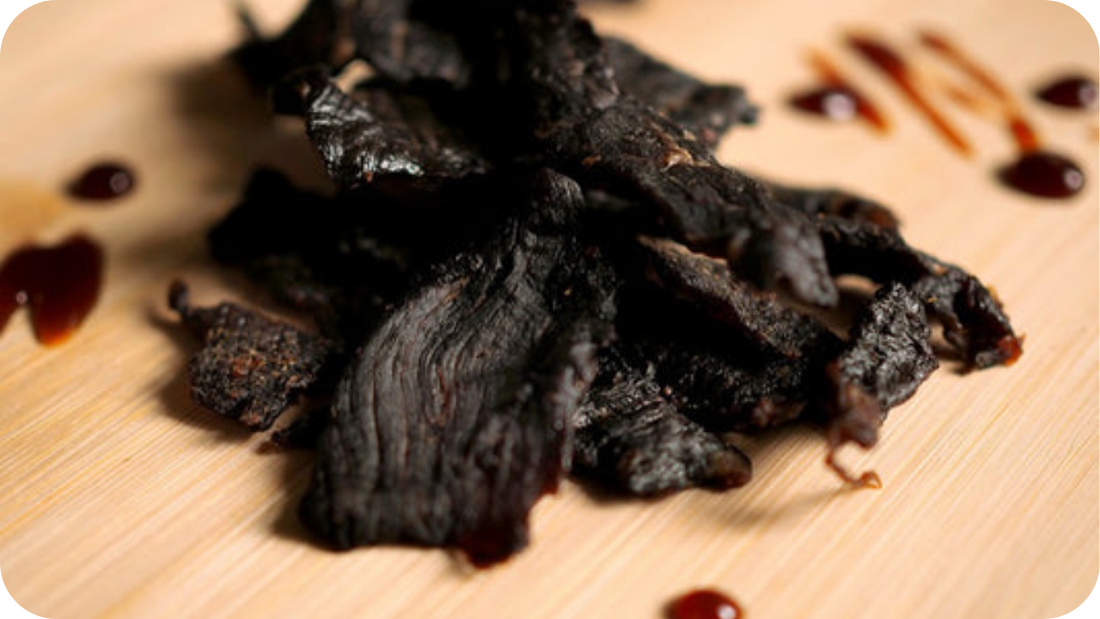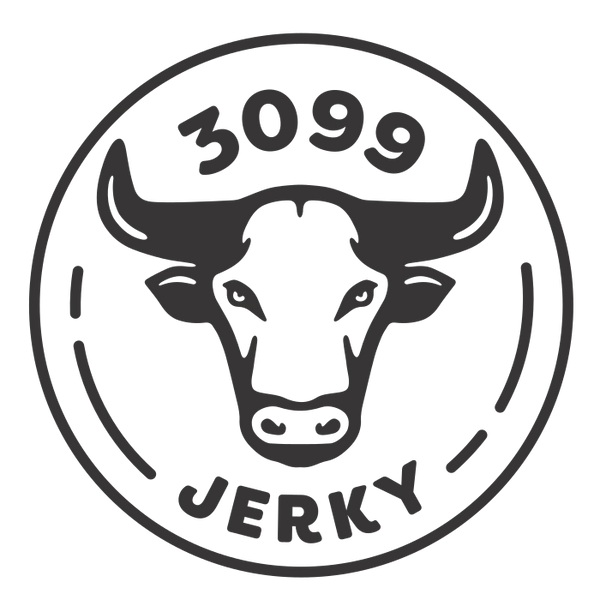
What Are the White Crystals on Jerky? (Hint: It’s a Good Sign)
Share
Spotted tiny white crystals on your jerky and thought, uh-oh, is this mould? You’re not alone, heaps of Aussies have had the same reaction. It’s easy to assume the worst. No one wants to bite into something questionable, especially when it costs a pretty penny. But hold that bin lid!
Those white flecks? They’re often a sign of top-tier, properly cured jerky. In this guide, I’ll explain exactly what they are, how to tell the good from the bad, and why they’re a delicious clue.
What Are the White Crystals on Jerky?
The white crystals on jerky are usually harmless salt or amino acid deposits, such as tyrosine, formed during the drying and curing process. These indicate proper preservation and high protein content. Unlike mould, they appear dry, white, and embedded in the meat. If there is no fuzzy texture or sour smell, the crystals are a good sign, not a warning of spoilage.
What Causes These Crystals to Form?
Ever spot tiny white flecks on jerky and freak out? Relax, here’s what causes those crystal formations to appear.
- Moisture Loss During Drying: As jerky dries, moisture evaporates from the meat's surface, leaving salt behind. This salt then crystallises, forming visible white specks. It’s a natural part of the dehydration process.
- Protein Breakdown (Tyrosine Crystals): When protein-rich meat breaks down over time, it can release amino acids like tyrosine. These cluster and harden into crystals, especially in well-aged jerky. It’s a sign of quality, not contamination.
- Fat Migration and Cooling: Temperature shifts during storage can cause fats to melt slightly and rise to the surface. As the jerky cools, these fats solidify into white, waxy spots. This is known as fat bloom and is a common occurrence in cured meats.
- Vacuum Sealing and Storage Conditions: Tightly sealed packaging can push salts or fats to the surface due to pressure differences. Over time, this creates visible crystals. Proper sealing and cool storage help minimise the effect.
Amino Acid Crystals: The Tyrosine Effect
Not all white specks on jerky are salt; some are amino acid crystals, most commonly tyrosine. These form during the curing and ageing process when proteins naturally break down and release individual amino acids. As the jerky dries, tyrosine can migrate to the surface and crystallise into tiny, dry white spots.
This effect isn’t a flaw; it’s often a hallmark of premium, protein-rich meat. You’ll even find tyrosine crystals on aged cheeses like Parmesan or cured hams, where they’re celebrated as a sign of proper ageing and flavour development. In jerky, they indicate that the meat was processed slowly and correctly.
Unlike mould, tyrosine crystals are dry, embedded, and have no odour. They don’t affect taste negatively; in fact, many meat lovers see them as a badge of honour. So, next time you see them on your 3099 Jerky, know you’re holding a high-quality, healthy, well-crafted product.
How to Tell the Difference Between Crystals and Mould
White stuff on jerky? Don’t stress, here’s how to tell if it’s a tasty crystal or dangerous mould in disguise.
1. Appearance
Crystals typically look like dry, powdery specks or tiny granules, often white or slightly off-white. They can appear shiny under light and are usually embedded in the surface.
Mould, by contrast, looks fuzzy or cotton-like, with colours ranging from green and blue to grey or black. It grows outward in patches and never appears polished or grainy.
2. Texture
When touched, crystals feel hard, chalky, or coarse, almost like tiny grains of salt or sand. They won’t smear or come off easily.
Mould, however, feels soft, fuzzy, or sometimes slimy. If you lightly rub your finger over it and it spreads or smudges, that’s a clear sign you’re dealing with mould and not harmless crystallisation.
3. Smell
Depending on the flavour, Jerky with white crystals smells just like it should, smoky, savoury, or peppery. Crystals don’t alter the smell.
Mouldy jerky, however, has a sour, damp, or “off” odour that’s unmistakable. If the smell makes you hesitate or wrinkle your nose, trust your gut; spoiled meat carries a distinct and unpleasant scent.
4. Spread
Crystals form in isolated spots or light clusters and don’t spread across the jerky. They appear more like dry residues than growing organisms.
Mould tends to spread in irregular patches, often starting in one area and creeping outward. If you see an expanding fuzzy patch, it’s mould, not a crystal. The difference in pattern is quite noticeable.
5. Cause
Crystals develop naturally during the curing or drying process as salt, fat, or tyrosine (an amino acid) rises to the surface and solidifies. It’s a regular part of preserving high-quality jerky.
Mould, however, forms due to excess moisture, exposure to air, or poor storage. It signals spoilage and should never be eaten or brushed off.
How to Store Jerky to Avoid Confusion
Smart storage keeps your jerky fresh, safe, and crystal-clear, literally. Here’s how to prevent mix-ups between spoilage and quality.
- Keep It in a Cool, Dry Place: Heat and humidity can cause fat and salt to rise to the surface, forming crystals. Storing jerky away from direct sunlight in a pantry or cupboard helps preserve its texture. Always avoid places like the glovebox or a steamy kitchen.
- Reseal After Every Use: Leaving jerky exposed to air increases moisture uptake, accelerating mould growth. After opening, always reseal the original packaging tightly or transfer to an airtight container. Oxygen exposure shortens shelf life, even with top-quality jerky.
- Use Proper Containers: Airtight containers or zip-lock bags prevent moisture and air from creeping in. This helps avoid false signs of spoilage, like fat bloom or softened texture. Clear containers also allow you to visually inspect the jerky without opening it frequently.
- Refrigerate for Longer Storage: If you won’t finish the jerky within a few days of opening, refrigeration is a smart move. It reduces the chance of mould and extends freshness. Just let it come back to room temperature before snacking for the best flavour.
- Avoid Cross-Contamination: Touching jerky with wet or dirty hands can introduce bacteria or moisture. Always use dry hands or tongs to handle a piece, especially when using shared bags. It keeps the remaining jerky fresher and safer to eat.
When to Toss It: Warning Signs of Spoiled Jerky
Not all jerky lasts forever; spotting these warning signs can save your stomach and snack stash from disaster.
- Visible Mould: If you see fuzzy growth in green, blue, grey, or black patches, that’s mould, not crystals. Mould spreads quickly and signals contamination. Once mould appears, the entire pack is compromised and should be thrown out.
- Off or Sour Smell: Jerky should smell smoky, savoury, or spiced, never sour or musty. A sharp, unpleasant odour is a clear indicator of spoilage. If the smell makes you hesitate, don’t risk it.
- Slimy or Damp Texture: Spoiled jerky can feel sticky, wet, or overly soft. This indicates it has absorbed moisture, creating a breeding ground for bacteria. Jerky should be dry and firm, not soggy.
- Damaged or Open Packaging: Broken seals or punctured vacuum packs allow air and bacteria. If the packaging looks bloated or has lost its seal, the jerky inside may no longer be safe. Always check the integrity of the pack before eating.
- Expired or Improperly Stored: Check the use-by date and storage instructions. Jerky left in hot or humid environments can spoil even before its expiry. It's best to toss it when in doubt, especially if it’s been sitting out for too long.
Why You Can Trust 3099 Jerky
At 3099 Jerky, we don’t cut corners - only premium cuts of 100% grass-fed Australian beef. Our jerky is made using traditional slow-drying methods, ensuring every piece is packed with flavour and naturally preserved: no shortcuts, fillers, and artificial nasties.
We’re transparent about what goes into our jerky and how it’s made. Each batch undergoes strict quality checks, from farm to bag, ensuring you receive a safe, clean product of the highest quality. If you spot white crystals on our jerky, they’re more likely a sign of high-protein content and proper curing, not something to worry about.
Our customers know the difference, and so will you, bite after bite. With trusted local sourcing, flavour-first recipes, and no hidden junk, 3099 Jerky delivers more than just a snack. It delivers peace of mind.
Still unsure? We’re always happy to answer your questions and help you choose your next favourite flavour. That’s the 3099 way.
Don’t Panic, White Crystals Mean Flavour & Quality
White crystals on jerky aren’t a fault, they’re often a flavour-packed sign of quality. From salt to tyrosine, they show that your snack has been properly cured and not spoiled.
So next time you spot them, snack with confidence! Ready for high-protein, crystal-kissed goodness? Grab your next bag of 3099 Jerky and taste the difference real Aussie craftsmanship makes.
